Ministry of Tribal Affairs
Janjatiya Gaurav Divas: Celebrating Tribal Heritage
Posted On:
14 NOV 2024 1:11PM by PIB Delhi
Bhagwan Birsa Munda taught us how to live in harmony with our surroundings and be proud of our culture. Inspired by him, we are working to fulfil his dreams and to empower our tribal communities.
~ Prime Minister Shri Narendra Modi
Introduction
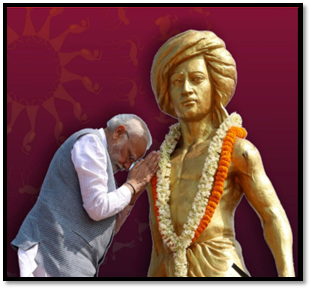
India’s rich cultural diversity is largely shaped by its tribal communities, who have played a crucial role in the nation’s history and development. Every year on November 15th, Janjatiya Gaurav Divas is celebrated to honor the contributions of these communities, especially in India’s freedom struggle. The day marks the birth anniversary of Bhagwan Birsa Munda, a tribal leader and freedom fighter, whose legacy continues to inspire. This occasion highlights the important role of tribal groups in preserving India’s heritage and advancing its progress.
Background
Since 2021, Janjatiya Gaurav Divas has been celebrated with great zeal across India to honor the sacrifices of tribal freedom fighters. The tribal communities played a vital role in India’s freedom struggle, with movements like those led by the Santhals, Tamars, Kols, Bhils, Khasis, and Mizos, among others. These revolutionary struggles were marked by immense courage and sacrifice, but their contributions were often overlooked by the wider public.
Tribal movements against British rule, like the Ulgulan (Revolution) led by Birsa Munda, were not only pivotal in challenging British oppression but also inspired a national awakening. Birsa Munda, revered as Bhagwan by tribal communities, led a fierce resistance against the exploitative colonial system, making his birth anniversary on 15th November a fitting occasion to honor tribal heroes.
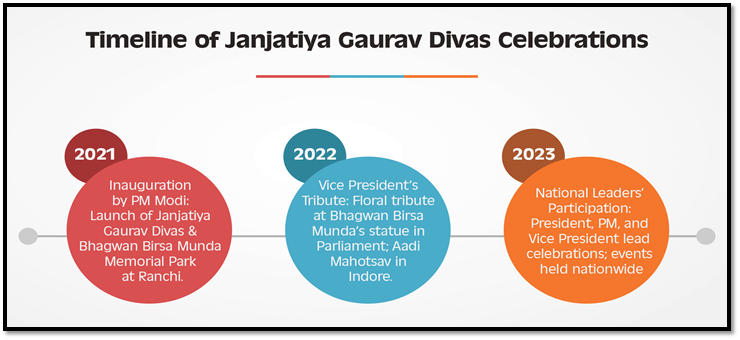 To ensure the sacrifices of these unsung heroes are never forgotten, the Indian government declared 15th November as Janjatiya Gaurav Divas during the Azadi Ka Amrit Mahotsav in 2021, marking 75 years of India's independence. The day celebrates the glorious history, culture, and heritage of tribal communities, with events held nationwide to foster unity, pride, and recognition of their significant contributions to India’s freedom and progress.
To ensure the sacrifices of these unsung heroes are never forgotten, the Indian government declared 15th November as Janjatiya Gaurav Divas during the Azadi Ka Amrit Mahotsav in 2021, marking 75 years of India's independence. The day celebrates the glorious history, culture, and heritage of tribal communities, with events held nationwide to foster unity, pride, and recognition of their significant contributions to India’s freedom and progress.
Janjatiya Gaurav Divas Celebrations in 2024
In 2024, as part of the Janjatiya Gaurav Divas celebrations, marking the 150th birth anniversary of Bhagwan Birsa Munda, a special event was held on 13th November in Jashpur, Chhattisgarh. Dr. Mansukh Mandaviya, Union Minister of Youth Affairs & Sports and Labour & Employment, will lead the ‘Maati Ke Veer’ Padayatra (foot march) alongside MY Bharat Youth Volunteers. The Chief Minister of Chhattisgarh, Shri Vishnu Deo Sai, and other state ministers will also join the march to honor Birsa Munda's legacy. This event is a tribute to his pivotal role in India’s freedom struggle and a celebration of the remarkable contributions of tribal communities to the nation’s development.
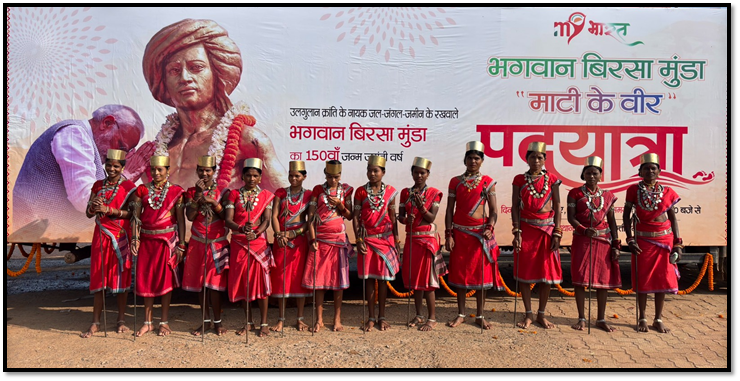
On November 15th, Prime Minister Shri Narendra Modi will visit Jamui, Bihar, to mark the commemoration of Janjatiya Gaurav Divas and the beginning of the 150th birth anniversary celebrations of Bhagwan Birsa Munda. The Prime Minister will also unveil a commemorative coin and postal stamp in honor of Bhagwan Birsa Munda. He will also inaugurate and lay the foundation stone for development projects worth over Rs 6,640 crore, aimed at improving infrastructure and uplifting tribal communities in rural and remote areas.
Prime Minister to Inaugurate and Lay Foundation for Key Development Projects:
- Grih Pravesh Ceremony: Prime Minister to participate in the inauguration of 11,000 houses under Pradhan Mantri Janjati Adivasi Nyaya Maha Abhiyan (PM-JANMAN).
- Mobile Medical Units (MMUs): Inauguration of 23 MMUs under PM-JANMAN and 30 additional MMUs under Dharti Aaba Janjatiya Gram Utkarsh Abhiyan (DAJGUA) to enhance healthcare access in tribal areas.
- Tribal Entrepreneurship & Education: Inauguration of 300 Van Dhan Vikas Kendras (VDVKs), 10 Eklavya Model Residential Schools for tribal students (worth Rs 450 crore) and foundation stone for 25 more Eklavya Model Residential Schools (worth Rs 1,110 crore).
- Cultural Preservation: Inauguration of two Tribal Freedom Fighters' Museums in Chhindwara and Jabalpur, MP and two Tribal Research Institutes in Srinagar, Jammu & Kashmir, and Gangtok, Sikkim.
- Infrastructure Development: Foundation stone for 500 km of new roads and 100 Multi-Purpose Centres (MPCs) under PM-JANMAN.
Schemes for the Welfare of Tribes
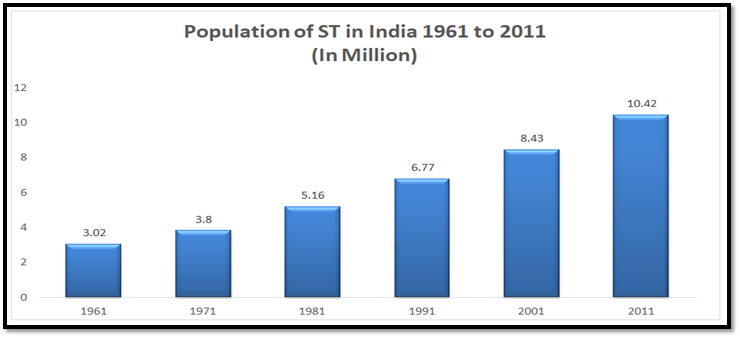
In addition to Janjatiya Gaurav Divas, the government has launched several programs and initiatives aimed at supporting tribal communities through socio-economic empowerment, sustainable development, and cultural preservation. According to the 2011 Census, India’s Scheduled Tribe (ST) population stands at 10.42 crore, or 8.6% of the total population, comprising over 705 distinct groups spread across remote and often inaccessible areas. To uplift these communities, the government has implemented various schemes that focus on improving education, healthcare, economic opportunities, and preserving tribal culture, ensuring their holistic development and integration into the national mainstream.
Government Initiatives and Financial Support for Tribal Development
The Indian government’s efforts for tribal development began with the Tribal Sub-Plan (TSP) in 1974-75, evolving into the Scheduled Tribe Component (STC) and the Development Action Plan for Scheduled Tribes (DAPST). These initiatives ensured coordinated tribal welfare across ministries. Financial support has grown significantly, with the DAPST budget increasing from ₹25,000 crore to ₹1.2 lakh crore in 2023-24. For 2024-25, the Union Budget has allocated ₹13,000 crore to the Ministry of Tribal Affairs, marking a 73.60% rise from the previous year.
Launch of Dharti Aaba Janjatiya Gram Utkarsh Abhiyan
On October 2, 2024, Prime Minister Narendra Modi launched the Dharti Aaba Janjatiya Gram Utkarsh Abhiyan in Hazaribag, Jharkhand. With an outlay of over ₹79,156 crore, this ambitious program aims to address critical gaps in social infrastructure, health, education, and livelihood development across approximately 63,843 tribal villages. The Abhiyan benefits over 5.38 crore tribal people across 549 districts and 2,911 blocks, spanning 30 states and Union Territories (UTs). It integrated 25 interventions across 17 ministries and departments of the Government of India.
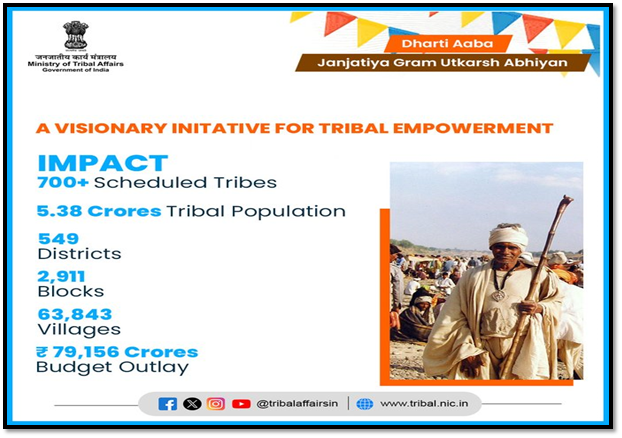
Pradhan Mantri Janjati Adivasi Nyaya Maha Abhiyan (PM-JANMAN)
Along with the Dharti Aaba program, the Prime Minister launched projects under the Pradhan Mantri Janjati Adivasi Nyaya Maha Abhiyan (PM-JANMAN). This significant initiative was launched by Prime Minister Narendra Modi on November 15, 2023, during Janjatiya Gaurav Divas in Khunti District, Jharkhand. This aims to uplift Particularly Vulnerable Tribal Groups (PVTGs). With a budget of ₹24,104 crore for 2023-24 to 2025-26, the initiative focuses on improving the quality of life for PVTG communities through targeted support, including Aadhar enrolment, community certificates, PM-Jandhan Yojana, and Ayushman cards. The mission emphasizes effective outreach, local engagement, and strong coordination to empower PVTG families and integrate them into India’s socio-economic mainstream.
The Pradhan Mantri Adi Adarsh Gram Yojana (PMAAGY)
The Pradhan Mantri Adi Adarsh Gram Yojana (PMAAGY) aims to provide basic infrastructure in villages with a significant tribal population. Under the scheme, 36428 villages having 50% tribal population and 500 Scheduled Tribes (STs) have been identified for providing basic infrastructure facilities in these villages, which includes villages in the Aspirational Districts identified by NITI Aayog.
Eklavya Model Residential Schools (EMRS)
The Eklavya Model Residential Schools (EMRS) were launched in 2018-19 as part of a Central Sector Scheme to provide quality education to Scheduled Tribe (ST) children in remote areas, offering them opportunities for higher education and employment. These schools follow the Navodaya Pattern and accommodate 480 students from Class VI to XII.
As of now, 1.29 lakh tribal students are enrolled across these schools. The government has approved a total of 728 EMRS schools, with 440 new schools (excluding 12 overlapping locations) proposed to be established under the current scheme, further expanding access to quality education for tribal communities.
Key Government Scholarships and Fundings for Tribal Empowerment
The government offers various scholarships and financial support to empower tribal communities, focusing on education and skill development.
1. Pre-Matric and Post-Matric Scholarship Schemes
These scholarships aim to reduce dropout rates and support tribal students' education:
- Pre-Matric Scholarship: Financial assistance for ST students in Classes IX and X, promoting the transition to secondary education.
- Post-Matric Scholarship: Financial aid for ST students from Class XI to post-graduate courses, supporting higher education.
2. National Overseas Scholarship for ST Students
This scheme offers meritorious ST students the chance to pursue post-graduate, doctoral, and post-doctoral studies at international universities. With an emphasis on excellence and global exposure, the government grants 20 awards annually, with 30% reserved for female candidates.
3. National Fellowship for ST Students
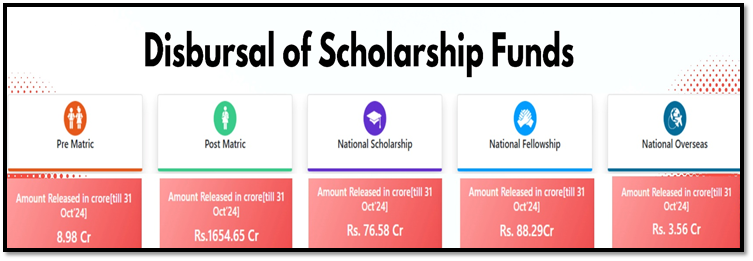 This fellowship scheme supports tribal students pursuing higher education through a fully digital process, ensuring timely financial assistance and grievance redressal via DigiLocker integration.
This fellowship scheme supports tribal students pursuing higher education through a fully digital process, ensuring timely financial assistance and grievance redressal via DigiLocker integration.
Schemes for Income Generation and Economic Empowerment
The government has launched several schemes to empower tribal communities, focusing on income generation and economic development.
- The Term Loan Scheme offers soft loans up to 90% of business costs, with repayment terms of 5 to 10 years.
- The Adivasi Mahila Sashaktikaran Yojna (AMSY) provides concessional loans up to ₹2 lakhs at 4% interest for tribal women.
- The Micro Credit Scheme supports tribal self-help groups with loans up to ₹5 lakhs.
- The Adivasi Shiksha Rinn Yojana (ASRY) provides soft loans for tribal students pursuing higher education. These initiatives aim to boost entrepreneurship, education, and self-reliance among tribal populations.
Health Initiatives for Improved Outcomes
The government has launched several health initiatives aimed at improving outcomes for tribal communities, focusing on disease prevention and healthcare access.
1. Sickle Cell Anaemia Elimination Mission
Launched by Prime Minister Modi on July 1, 2023, in Madhya Pradesh, the mission targets the elimination of Sickle Cell Disease (SCD), a genetic blood disorder prevalent among tribal populations in Central, Western, and Southern India.
2. Mission Indradhanush
Immunization Campaign focuses on ensuring full immunization for children up to two years of age and pregnant women, with a special emphasis on tribal communities. The mission has extended its services to provide free COVID-19 vaccines, further ensuring healthcare access for tribal populations. Goal of mission is to increase immunization rates and reduce vaccine-preventable diseases in underserved areas, especially in tribal regions.
3. Nikshay Mitra Initiative
The Nikshay Mitra Initiative targets tuberculosis (TB), offering diagnostic, nutritional, and vocational support to TB patients, particularly those from tribal communities. Provides additional support for TB patients, including nutritional assistance and vocational training to enhance recovery. Focus on tackling TB effectively in tribal areas, improving health outcomes and encouraging early detection and treatment adherence.
5. National Health Mission (NHM) and Haemoglobinopathy Guidelines
The National Health Mission under the Ministry of Health and Family Welfare developed comprehensive guidelines for the prevention and control of haemoglobinopathies, including Sickle Cell Disease (SCD), which are common among tribal population. Recognizing the severe impact of SCD, the government is intensifying efforts toward its eradication through screening, awareness campaigns, and improving healthcare access.
6. Pradhan Mantri Matru Vandana Yojana: Supports maternal and child health, offering financial assistance to tribal women for prenatal and postnatal care.
Honouring and Celebrating India’s Tribal Communities
To honour the sacrifices of tribal freedom fighters, the government has sanctioned the establishment of 10 Tribal Freedom Fighters' Museums across states where tribals fiercely resisted British rule. On November 1, 2022, Prime Minister Narendra Modi announced plans to develop Mangarh Dham in Rajasthan’s Banswara district, a site where over 1,500 Bhil freedom fighters were martyred in 1913 during a British massacre. This memorial, a collaborative effort between Rajasthan, Gujarat, Madhya Pradesh, and Maharashtra, will serve as a national tribute to tribal resilience and cultural heritage.
All these initiatives, along with other steps taken by the government, have paved the path of bringing the tribal communities into the mainstream while honouring their cultures, legacies and ways of life.
Conclusion
The government has introduced various initiatives to empower these communities, focusing on education, health, and socio-economic development. By raising awareness and fostering solidarity, we can ensure the preservation of tribal cultures while improving their quality of life and integrating them into India’s progress. Through these efforts, tribal communities can continue to thrive and contribute to the nation’s growth. Janjatiya Gaurav Divas highlights the importance of preserving tribal heritage and honoring the contributions of tribal communities.
References
Click here to see in PDF:
Santosh Kumar/ Ritu Kataria/ Kamna Lakaria
(Release ID: 2073246)
Visitor Counter : 14995